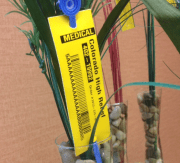Colorado’s top marijuana cop has a simple message for the local cannabis industry: study up on the state’s new inventory tracking system, because it could save your business and keep regulators off your back.
“There is no substitute for being a student of [the system] and the other regulations,” said Lewis Koski, chief investigator for Colorado’s Marijuana Enforcement Division (MED). “If they are in compliance then it puts us in a situation that, if there are other violations, we can work with them on a solution.”
In fact, Koski said the system will be the MED’s primary tool in governing the industry when recreational marijuana sales begin on Jan. 1. And going forward, many of the MED’s unannounced site visits will be based on non-compliance with the system.
“We might have a situation where one or two shipments didn’t make it to the final destination. Or a grower is over their plant count one month, then under the next, then over the next and so forth,” Koski said. “The system will tell us that, and that raises [a business’s] risk factor.”

System at Heart of Enforcement
Koski helped roll out the state’s Marijuana Inventory Tracking System (MITS) on Wednesday in Denver. The system requires growers and dispensaries to attach radio frequency tags onto all plants and marijuana packages, and then upload tracking codes from these tags into a statewide database that is overseen by the MED. The system will then track all marijuana products, from the seed – or clone – the final sale.
It was designed in part to be the heart of the MED’s enforcement strategy for both medical and recreational marijuana.
Businesses deemed to be risky due to non-compliance will be targeted by MED investigators, who carry gun-like scanners that can register multiple tags in a single room with the push of a button. The scanners, which look like the devices used at ski resorts to check lift tickets, can also pinpoint individual plants.
Koski said the scanner method can also measure plant parts that are being used to synthesize edibles and infused products, because business owners must account for these plant parts in reporting system.
The agency hopes to have a full staff of 55 employees by the summer of 2014. It would not comment on how many investigators are currently working in the field, but even with a full staff, the MED will rely heavily on the MITS for identifying infractions.
Other Enforcement Strategies
Koski said there won’t be sweeping changes to the MED’s other enforcement strategies after Colorado rolls out recreational marijuana legalization on Jan. 1. The MED will continue to target newer businesses over established ones, he said. It will also schedule unannounced drop-ins to new cultivation facilities during their first harvest. Koski did not provide details of the specific infractions that the MED commonly sees in new or veteran businesses.
“With regard to violations, newer businesses tend to have a broader range of problems,” Koski said. “The more-experienced [businesses] are more sophisticated, so their [infractions] tend to be minor.”
 And the MED will continue to act with leniency toward business owners who can prove they are trying to follow the rules.
And the MED will continue to act with leniency toward business owners who can prove they are trying to follow the rules.
Koski said he realizes that coming up to code takes time, money and manpower. The MED, he said, walks a tightrope: on one hand it wants to protect the public; on the other it does not want the rules to be so complex they hurt the marijuana businesses.
That’s why the MED gives violators numerous chances to correct problems before the punishments threaten a business, he said.
“We use a verbal warning first, and if it continues, we amp up our enforcement,” Koski said. “When we get compliance over the long haul, we consider that a victory.”
Photo credit: Fred Dreier




